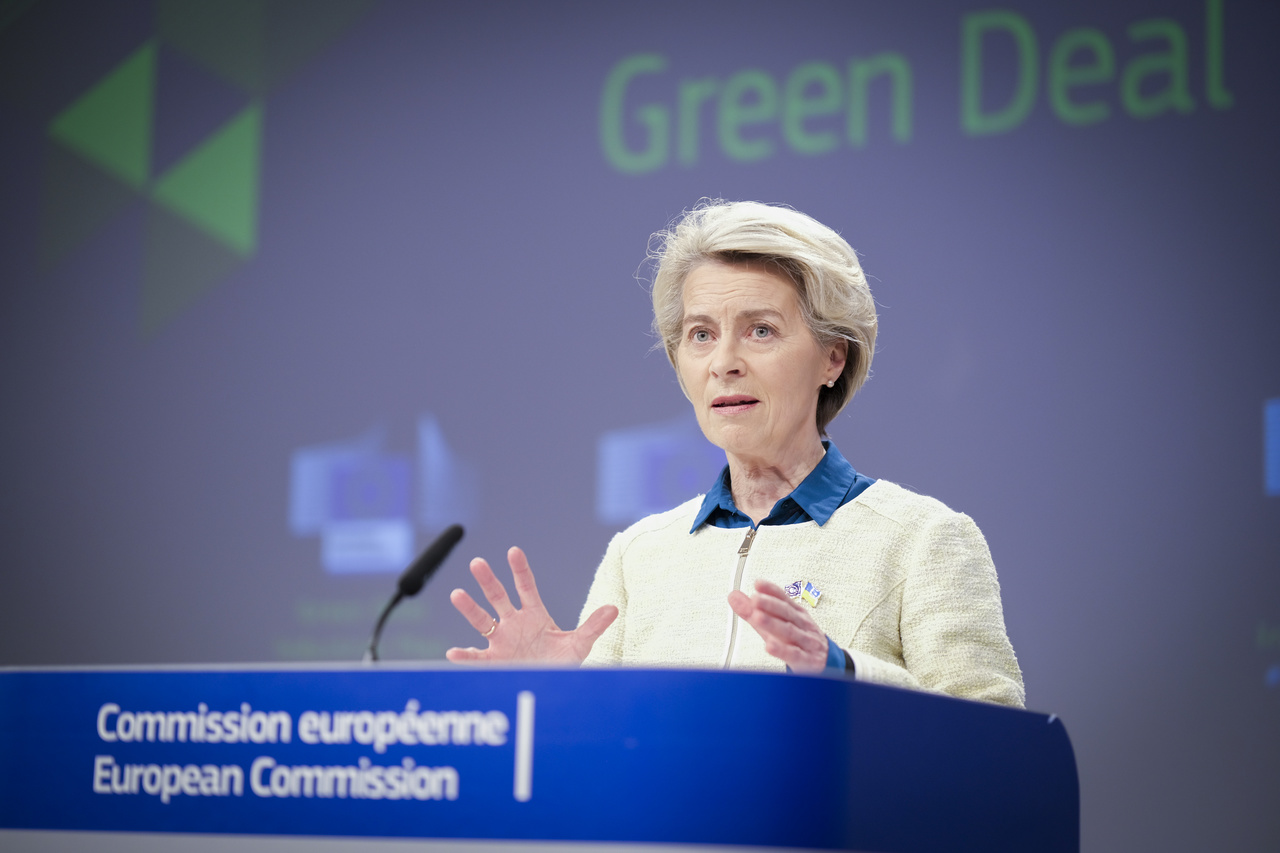EU Mechanism Aims to Reduce Carbon Leakage
The gradual introduction of the Carbon Border Adjustment Mechanism (CBAM) by the European Union will reduce global greenhouse gas emissions as well as international trade. The mechanism will support EU industry, which bears the high emissions costs of community climate policy, reducing its global competitiveness. CBAM burdens Member State administrations on which the initiative’s success depends. It could also affect the economies of developing countries, the consequences of which could be minimised by, among other things, the introduction of transition periods and the redistribution of funds to the EU’s trading partners.
 Nicolas Landemard / Zuma Press / Forum
Nicolas Landemard / Zuma Press / Forum
As part of the “Fit for 55” package, the European Commission (EC) in 2023 reformed the EU’s climate policy instruments, including the European Union Emissions Trading Scheme (EU ETS). Participants (in the industrial and energy sectors) are obliged to account for the greenhouse gas (GHG) emissions they generate by purchasing and redeeming emission allowances. The reform envisages a gradual decrease in the number of allowances, including the elimination of free allowances (granted to some sectors) and a consequent increase in the price of the remaining ones, which is expected to impose measures to reduce emissions. This has the effect of increasing the cost of doing business for EU industry, reducing its global competitiveness. Thus, it becomes profitable for companies to relocate part of their production outside the EU or import materials and intermediates. This is known as “carbon leakage”. To tackle it, in 2023 the EU adopted a border tax on GHG emissions, the CBAM. The main objectives of the mechanism are to decarbonise industry around the world and counter the relocation of production outside the EU.
The Principles of CBAM
The mechanism is being implemented in two phases: an interim phase (from October 2023) and a final phase (from 2027). For now, CBAM applies to a few categories of goods: cement, steel, aluminium, fertilisers, hydrogen, and electricity. Its scope is to be expanded to cover, in the final instance, all products from sectors that are subject to the EU ETS. The mechanism applies to goods imported from countries outside the EU, excluding those participating in the EU ETS or related schemes (Iceland, Liechtenstein, Norway, Switzerland).
The final objective of the CBAM is to be a tax on carbon-intensive goods imported into the EU. The mechanism is to be based on the purchase and surrender of CBAM certificates for redemption by the importer of a number corresponding to the amount of emissions released in the production of goods produced outside the Union. The value of the certificates will be able to be reduced by the applicable emission fees paid in the country of origin. The cost of CBAM certificates is to be linked to the price of EU ETS allowances, and their number will remain unlimited. The importer will be responsible for determining and verifying emissions and carrying out reporting obligations. Violation of these duties will be sanctioned by fines, including the withdrawal of permission to import CBAM goods into the EU customs territory. This will be the responsibility of the national administration (in Poland, the customs and tax services and the National Centre for Emissions Management, KOBiZE), supervised by the EC.
Only obligations involving information will fall on importers during the transitional period, which lasts until the end of 2026. CBAM is already a burden for businesses at this stage, obliging them to do the costly administrative and technical work of determining emissions for imported goods every quarter in accordance with EU regulations. These provisions are highly complex due to the need to consider the specificities of different goods and production processes. This poses a risk of abuse, particularly in countries where the state exercises effective control of companies (e.g., China). CBAM excludes weaker actors from trade: smaller EU importers and developing country producers that lack the appropriate knowledge and technology to calculate and report emissions. The mechanism’s functioning challenges Member States’ customs and administrative authorities, on which the effective and consistent implementation of CBAM depends. Uneven implementation could lead to third-country producers exporting their goods to the EU through countries with the most lenient approach to CBAM implementation. At the end of the transitional period, the EC will review the regulations and present its conclusions about the transitional phase. The mechanism itself, the scope of goods covered, and the timetable for its implementation may also be reviewed.
Consequences
The implications of CBAM for the EU are still not fully recognised. In the climate dimension, the mechanism can be expected to significantly reduce the problem of “carbon leakage”, resulting in a global reduction in emissions (by about 0.3% in the sectors covered by CBAM globally and 13% in the EU). In the trade dimension, CBAM will not improve the competitiveness of EU businesses vis-à-vis third-country operators in global markets, and will decline as a consequence of EU ETS reform. This is because EU traders must bear high emission costs that are not similarly charged to foreign producers, making goods produced in the EU more expensive and less attractive. According to EC calculations, this will lead to an estimated 7% decrease in the value of CBAM exports. The solution proposed by EU industry (but not in line with WTO rules) could be to introduce export rebates to offset the cost of the emissions. However, the decrease in external trade is expected to be accompanied by increased production for the EU internal market and increased trade in goods between Member States. CBAM also will result in an average 5% increase in the price of goods covered by the mechanism, except electricity. Its implementation will result in additional budgetary revenues, estimated to be around €9 billion annually after 2030. It is envisaged that 25% of the funds will go to the Member States, while the EC will redistribute 75% to the EU’s hardest-hit low-income trading partners to encourage decarbonisation initiatives. Objections to this arrangement, as subjective and neo-colonial, are being raised by developing countries.
The scale of the mechanism’s impact on third countries will vary. Eastern European and Balkan economies, as well as Morocco, Mozambique, and Tajikistan, among others, are the most vulnerable to declines in exports to the EU and production (and consequently employment, investment, and GDP). Allegations of protectionism in order for the EU to gain trade advantages are also formally raised by the BRICS, which, anticipating a sizeable absolute decline in its members’ exports to the Union, is threatening to file a complaint to the WTO. Nonetheless, the introduction of CBAM has been a catalyst for some countries (e.g., Türkiye) to intensify their work on setting their own GHG emission tariffs, an indirect objective of the mechanism.
The introduction of CBAM may also provide the impetus for developing so-called climate clubs, that is, multilateral agreements involving third countries and the EU applying the integration of climate policy and law and mutual exemptions from emission tariffs. Such a solution is being pushed by German diplomacy and has met with interest from some countries (e.g., Japan, Canada, the U.S., and the UK). Establishment of such clubs would strengthen cooperation in the area of climate policy. A task force set up by the G7 is working on establishing one such club. Alternatives being discussed internationally include the development of a global emissions trading mechanism (discussed at COP summits) and bilateral harmonisation of emissions taxes with the EU (which Australia, among others, is preparing).
Conclusions
The effectiveness of the CBAM mechanism will depend on effective implementation by the Member States. In the interim period, ongoing analysis of the regulations in cooperation with business and adaptation of the implementation timetable and commodity list remain crucial. The mechanism should, in the longer term, stop the flight of industry from the EU, including Poland, reducing the risk of disruption to supply chains. The problem remains the expected decrease in cost competitiveness of EU firms in global markets due to the implementation of the EU ETS.
The decline in exports from developing countries, including the BRICS group, likely to result from CBAM may result in deteriorated relations with the EU and lead to disputes before the WTO. However, the mechanism will improve the EU’s negotiating position internationally in talks to meet ambitious climate targets. In the long term, it represents an opportunity to create a global emissions trading mechanism and reduce the competitive advantage of companies not bearing the costs of emissions. In the interim, transitional periods could be negotiated for the EU’s most vulnerable trading partners (particularly for neighbouring countries) or a transparent redistribution of the funds raised.


.png)

